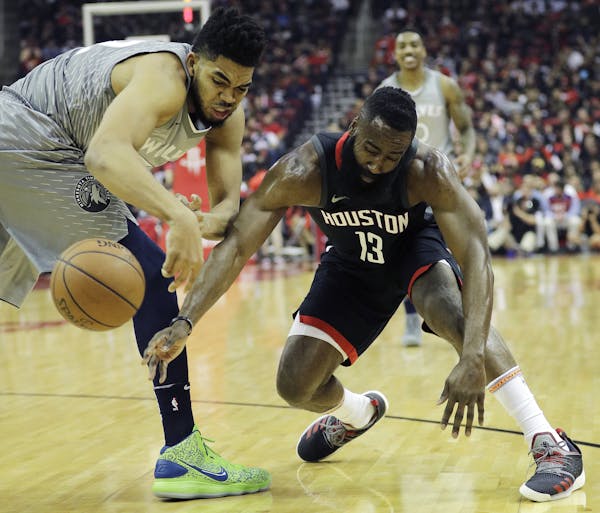At the end of the NBA's regular season, the Houston Rockets earned a distinction that might not be theirs for long. The Rockets finished the season with 3,470 three-point attempts and 3,436 two-point attempts, becoming the first team in NBA history to attempt more three-pointers than two-pointers.
The trend toward chucking more and more three-pointers has spiked in recent years in the NBA — teams averaged 29 three-point attempts per game, up from 22.4 in the 2014-15 season — and the Rockets are at the forefront of that movement while taking it to new extremes.
The team broke its own league record for most three-pointers attempted in a season (42.3 per game), and they still took 546 more three-pointers than the team with the second most, the Brooklyn Nets.
The Wolves certainly know the Rockets are going to chuck it from deep, so the question becomes how best to defend the Rockets? It might help to look at where on the floor the Rockets and some of their players prefer to shoot.
NBA.com breaks down three-pointers into right-corner, left-corner and "above the break." Above the break means the wings or top of the key, or the part of the three-point line before the break extends into the corners. Corner three-pointers tend to be more efficient because that distance is shorter to the basket than above the break three-pointers. The Rockets were near the top in each category, but took 32.1 three-pointers per game above the break, hitting them at a clip of 35.3 percent. From the corners, the Rockets hit at a rate of 39.6 percent.
The Rockets have two players whose main jobs are to try and get corner three-pointers: Trevor Ariza and P.J. Tucker. Most everyone else on the Rockets, James Harden and Chris Paul included, take a heavy percentage of their threes from above the break. Harden, for instance, took 665 above the break and only 55 in the corners all season.
Ariza and Tucker shot above 40 percent on three-pointers from the corners. Their opportunities from those corners are made possible in part by the penetration Harden and Paul get on collapsing defenses and the ensuing ball movement. But when Ariza and Tucker took shots from above the break, those percentages dipped to the low 30s.
In Game 1, Ariza and Tucker took a combined five three-pointers from the corners, hitting only one. They took four from above the break and made none. The Rockets shot only 10 of 37 from three-point range Sunday, with Harden accounting for seven of those makes. So could you say the Wolves did a decent job of closing out on the Rockets shooters? Not quite.
The Rockets shot 33 three-pointers that were considered "open," meaning defenders were four to six feet away at the time of the shot, or "wide open," six or more feet away, according to tracking data on NBA.com. It would seem the Wolves were fortunate the Rockets shot so poorly. Unfortunately for them, they still lost the game.
Given how the Rockets have shot all season, a bounce-back seems reasonable to expect in Game 2, especially if the Rockets keep getting open looks. The Rockets are going to keep firing away, and if they recover from their Game 1 performance, the series could be over quickly.
Chris Hine is the lead writer for North Score, the Star Tribune's sports analytics beat. startribune.com/northscore E-mail: chris.hine@startribune.com
